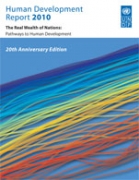Health
Status of water supply, sanitation and solid waste management in urban areas – A research study by CPHEEO (2005)
Posted on 11 Nov, 2010 10:16 PMThis study by the Central Public Health and Environmental Engineering Organisation (CPHEEO) assesses the status of water supply, sanitation and solid waste management in selected 300 cities and towns of India including all metropolitan cities and selected Class I and Class II urban centres. It estimates the requirement of funds for full coverage of population by these services in the urban areas of the country from 1999 to 2022 (at five yearly intervals). Overall, the study confirms the normal notion that the metropolitan cities are better provided for than the other size class of urban centres.
Effective interventional approach to control anaemia in pregnant women through avoidance of flouride - Current Science paper
Posted on 11 Nov, 2010 07:33 PMThis paper from Current Science deals with anaemia in pregnancy and low birth weight babies, which can lead to maternal and infant mortality, and continues to plague India and several other countries despite nutritional counselling and maternal iron and folic acid supplementation. It reports the results of fluoride avoidance as an approach to address the issue. The methodology of the research entailed the following -
Human development report 2010 - The real wealth of nations - United Nations Development Programme
Posted on 10 Nov, 2010 12:50 PMUnited Nations Development Programme (UNDP) has recently published the 20th Anniversary edition of its Human Development Report (HDR) which presents the latest Human Development Index (HDI). The premise of the HDI reports is simple - national development should be measured not simply by national income nor should an individual’s well-being be evaluated by money alone, as had long been the practice, but also by life expectancy and literacy.
Income is of course crucial - without resources, any progress is difficult. Yet there is a need to gauge whether people can lead long and healthy lives, whether they have the opportunity to be educated and whether they are free to use their knowledge and talents to shape their own destinies.
Heavy rains, cyclones and floods affect the life of millions; News Roundup (1-7 November 2010)
Posted on 09 Nov, 2010 08:09 PMRecent news indicates extensive reports on the threat and destruction unleashed by cyclone Jal in the three states of Andhra Pradesh, Karnataka and Tamil Nadu, with the states of Andhra Pradesh and Karnataka being affected the most. Cyclone Jal has led to heavy rainfall in both these states leading to floods and a heavy death toll in the coastal districts of both the states, besides reports of destruction of agricultural produce in the state of Karnataka.
South India
Andhra Pradesh
- Administration on high alert with the threat of cyclone Jal approaching the Andhra Pradesh coastline
- Cyclone 'Jal' claims lives in Andhra Pradesh
- Cyclone 'Jal' claims five lives in Andhra Pradesh
- Cyclone threat in Andhra, rains kill 20
- Andhra rains cause havoc, death toll rises to 25
- Rain claims 4 lives in Vizag, 2 in East Godavari
- Rain fury continues in Andhra Pradesh's coastal districts
- Heavy rains wreak havoc in coastal Andhra Pradesh
News roundup (22 - 31 October 2010) :" India: Land of many cell phones, but fewer toilets"
Posted on 03 Nov, 2010 08:50 AMWastewater/Sanitation
"Gujarat farmers fight against climate change: Adopt technoloxxgy to conserve resources and maximize benefits" : News roundup (15-21 October 2010)
Posted on 22 Oct, 2010 11:25 AMClimate Change
Brainstorming workshop on interface between water technology developers and other stakeholders by NEERI
Posted on 08 Oct, 2010 08:17 PMA workshop on developing interface between water technology developers and other stakeholders particularly those who actively address water policy issues namely officials of Department of Drinking Water and Sanitation, Public Health Engineering Department, NGOs, International Organisations and Professional Associations was held by the National Environmental Engineering Research Institute (NEERI) with support of the Department of Science and Technology (DST) at Nagpur on 7th September, 2010.
Protect the right to life considering the dignity of women who do not have access to a toilet
Posted on 30 Sep, 2010 10:26 AMSanitation - a big problem in India, as half the population of our country do not have access to this facility. Mumbai is one of the biggest cities in the world and advanced in terms of its commercialization. However, sanitation is one of the most common issues neglected. Our team of women from Jan Jagruti went into the lanes of 3 areas Azad Mohala, Bharatiya Kamla Nagar, Vijay Nagar and spoke to women to understand the severity of the sanitation issue prevailing. These areas have severe problems with public health, due to improper sanitation infrastructure and insufficiency of toilet facilities, compounded by numerous issues of flooding during the monsoon season. Khaaddi, a local area/dumping ground, is widely used by local residents for urination and defecation, leading to the spread of contagious diseases. Though women use paid toilets, the issue of cleanliness and waiting in long queues are the most common problem before them. It is very insecure for them when they use open spaces for defecation.
Grand Challenge: Create the next generation of sanitation technologies
Posted on 28 Sep, 2010 10:56 AM
Good water supply and sanitation is a major input for good health of population - India Health Report 2010
Posted on 27 Sep, 2010 12:49 PM Last week saw the publication by BS Books of the India Health Report 2010 (henceforth referred to as IHR10), edited (and mostly written) by Ajay Mahal, Bibek Debroy and Laveesh Bhandari. For anyone interested in India’s health status, access to health care and medicines, emerging health problems, the infrastructure of health services, medical ethics, health-care financing, government programmes and regulations and key issues in health sector reform, this 138-page report is an excellent introduction-cum-survey. Here I provide a highly selective summary to whet the appetite of readers to peruse the full report.
Last week saw the publication by BS Books of the India Health Report 2010 (henceforth referred to as IHR10), edited (and mostly written) by Ajay Mahal, Bibek Debroy and Laveesh Bhandari. For anyone interested in India’s health status, access to health care and medicines, emerging health problems, the infrastructure of health services, medical ethics, health-care financing, government programmes and regulations and key issues in health sector reform, this 138-page report is an excellent introduction-cum-survey. Here I provide a highly selective summary to whet the appetite of readers to peruse the full report.






